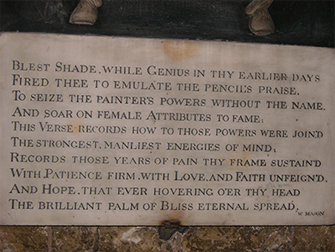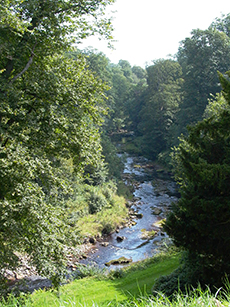History of Rokeby Park

Memorial to Anne Morritt in Selby Abbey
An original and effective variant of the Palladian formula, Rokeby Park was built by Sir Thomas Robinson ca. 1730.
It was acquired by J.S. Morritt in 1769, in whose family it has remained ever since.
Paintings and period furniture are on display, together with a unique collection of needlework pictures by Anne Morritt (d. 1797) and an unusual 'Print Room'.
The house, known as the setting for Sir Walter Scott's ballad 'Rokeby', is open to the public and group visits are welcomed.
2014 Opening Times: Monday 5th May then each Monday and Tuesday from May 26th until September 2nd inclusive, 2.00pm - 5.00pm (last admission 4.30pm).
The Robinson family acquired the Rokeby estate in the early 17th century. Thomas, the creator of the present house, succeeded his father in 1720, at the young age of 18. Deeply interested in architecture, 18thC engravings of Rokeby bear the words 'Thos. Robinson, Architectus'.
He was captivated by the designs of the 16th C Venetian architect Andrea Palladio, whose ideas were becoming fashionable in England through their publication and promotion by Richard Boyle, 3rd Earl Burlington (1694 - 1753). Robinson knew Burlington well and was encouraged by him to build in the new style.

Robinson was also influenced by contemporary antiquarian interest in the buildings of Roman Britain and in the attempt by Robert Castell (d. 1728), a protégé of Burlington, to reconstruct a Roman Villa. It is in this context that the Architectural Historian, the late Giles Worsley, described Rokeby as 'a particularly erudite conception'.
J.S. Morritt acquired the house from Robinson in 1769 and made various improvements, constructing a new stable block, by John Carr of York, further away from the house. In the late 19th C, his grandson R.A. Morritt added a second storey to the east pavilion to accommodate his large family. The extensions were carefully designed to be in keeping with the Georgian elevations.
Rokeby has had a number of distinguished inhabitants. 'Long Tom' Robinson, so called because of his lanky build, is better known as the architect of the west wing of Castle Howard. In the 1740s he was Governor of Barbados and later proprietor of the Ranelagh Pleasure Gardens. There is a memorial to him and his wife in Westminster Abbey.
J.B.S. Morritt (1771 - 1843), who owned the house for over 50 years, was a close friend of Sir Walter Scott. A cultivated scholar and lover of the arts, it was he who acquired Velázquez 'Toilet of Venus' in 1809.
Subsequently famous as the 'Rokeby Venus', it was sold to the National Gallery in 1906. A copy by WA Menzies, in the original frame, now hangs in the Saloon (See Image). In 1794 - 96 he made a Grand Tour which daringly included Greece and Anatolia.






